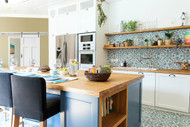A Guide to Interior Design Styles: Mediterranean
Jul 22nd 2020
Mediterranean design has serious history to its name. First appearing in the United States in the early 1900s, Mediterranean Revival was the precursor to today's Mediterranean, with a lively heyday in the 1920s and 1930s. Revival style, which gave a nod to earlier styles like Spanish Colonial Revival and Mission Revival, mixed classic with modern, and luxury with rustic, and it did so in a way both elegant and every day.
Modern Mediterranean style evokes the sun-drenched valleys and coastal stretches of the Mediterranean region, particularly those in Spain, Greece, and Italy. However, it sometimes extends borders to encompass Moroccan, French, Egyptian, and Turkish details too. The style is both brighter and sleeker than its forebears, evoking Southern European comfort and opulence in a streamlined finish.
We love Mediterranean design for its airy spaces, natural materials, lively yet earthy colors, and indoor-outdoor living.
Colors from NatureThis style knows how to blend color for a look both timeless and modern. While Mediterranean design focuses on colors from the natural world, it never shies from bringing in a color that's sure to impress.
Just like in a natural setting, you might see a pop of violet mixed with luxurious sage greens, or a burst of canary yellow in a outcropping of pale stone. But rather than an eclectic mishmash of colors, Mediterranean keeps things focused on one to three main colors.
Our favorite way to incorporate color in Mediterranean design is to use a layering effect. Try mixing one shade of green for the sofa and a deeper shade for the cushions and artwork. You could then add other elements in varying shades of beige or soft yellow. The trick is to keep the colors focused so that the look remains clean and uncluttered.
Shapely ArchitectureAnother feature in Mediterranean design is contrasting architecture. Arches over windows and doorways bring softness to this style, welcoming in the light and avoiding harsh angles. We love how rounded arches bring have a distinct look next to the firm lines of a wrought-iron balcony or window grille.
Seeing high ceilings and large windows is another hallmark of the Mediterranean style. Often, ceilings in living rooms, bedrooms, and other living spaces feature thick, dark-stained wooden beams that ground the architecture with rustic charm.
Wood, Metal, and StoneApart from wooden ceiling beams, wood plays an important part in furniture as well. Mediterranean design is big on wood furniture, particularly that with a dark walnut, espresso, or honey oak stain.
To bring out the most of this style, you'll want to include metal and stone elements as well. Terracotta or stone tiles are common in the design, with stone often making its way up the walls or along the fireplace. These materials are prominent across all indoor-outdoor living spaces, helping to take you from one space to the next with ease.
Our tip: don't think that plain stone or tile is the only way to go. Painted or glazed tiles feature in many Southern European homes, so it's natural for them to feature in the design style as well. From a bolder geometric tile in the kitchen or entryway to a vibrant blue tile in the guest bathroom, there are plenty of ways to add patterned tiles to Mediterranean interior design.
Decorate with TextureEven in simpler designs, Mediterranean style knows how to wow with texture. You might see vases or picture frames with roughened surfaces. You might see textured plaster on the walls or the ceiling. Accessories are also no stranger to texture, with cushions, throws, and rugs full of contrasting materials.
Mixed in with all that texture is an array of light fixtures, decor, and window treatments designed to bring the whole look together. To get the look, think wrought-iron, pottery, mosaic glass, wicker, lightweight fabrics, and plenty of fresh and dried herbs.
A Deeper Look at Mediterranean DesignWhile this style showcases a few key elements, it is also a fluid design that can swing in different directions. There are three main regional influences within Mediterranean style: Spanish, Italian, and Greek.
Spanish Mediterranean
Spanish Mediterranean mixes detail with clean lines. It's big on Moroccan tiles, mosaics, and intricate patterns set against smooth stucco walls and dark wood furniture. Spanish style likes to play with richer colors, such as mid-range blues, yellows, greens, and reds.
Italian Mediterranean
Italian Mediterranean likes to keep things a bit more earthy, with warm colors as its specialty. Gold, red, orange, beige, and soft brown feature prominently in both paler and deeper tones. This style is more likely to have more ornate furniture and textured stucco walls with creamy undertones.
Greek Mediterranean
Finally, Greek Mediterranean loves to contrast white with blue. You'll see plenty of white stucco walls paired with pops of blue, from cobalt to turquoise to cerulean blue. Sometimes, Greek style likes to include geometric design motifs like Greek meander keys, or else patterns like rosettes, arabesques, or laurel leaves. Furniture tends to be simpler and less dramatic, with the focus on the decor.
We love this style, and we hope you do too! To further define your Mediterranean design style, try adding a modern barn door like the Plank Barn Door or Chevron MDF Two Piece Barn Door. There's nothing like a sliding barn door to elevate your space.
